Nina Munteanu's Blog, page 9
September 6, 2014
Creating Science Fiction with Nina Munteanu at George Brown College
 I am again teaching my workshop-style course on how to write science fiction this fall at the St. James Campus of George Brown College in Toronto, Canada.
I am again teaching my workshop-style course on how to write science fiction this fall at the St. James Campus of George Brown College in Toronto, Canada.Called "Creating Science Fiction" the 12-week course runs Wednesday nights from 6:15 to 9:15 starting September 17 through to December 3. It costs $278.
I run the course like a workshop with lots of students input and feedback on their WIP.
Course Description: Learn about what is involved in writing science fiction and getting it published. Explore the essential tools used in this genre (including world building, research and plot approaches), and work toward a publishable original work by learning to generate and follow through with premise, idea and theme.
Here's what some students have said about the course:
Nina is:
“Sharing, open, lively.”
“Always willing to answer questions. Very supportive.”
“Very passionate about teaching, with a great logical presentation that makes it super easy to understand the concepts. Excellent teacher! I never mark all excellent.”
“She is helpful, makes us work on our writing, and cares about us.”
“She is a published author and gave us insight into the business & writing aspect of science fiction so she has a lot of hands-on knowledge & genuinely loves sci-fi.”
What other courses would you like us to offer?
“Science Fiction 2 with Nina—I’d pay double. She was (by far) the best instructor I have had in 2 years and several Writing Courses at George Brown.”

Students can register here: http://coned.georgebrown.ca/owa_prod/cewskcrss.P_CrseGet?subj_code=LIBA&crse_numb=9351
George Brown College is located on 200 King Street, Toronto, Canada.
See you in class!Nina
Published on September 06, 2014 20:44
July 19, 2014
Embracing Your Future: Flying Algal Ships
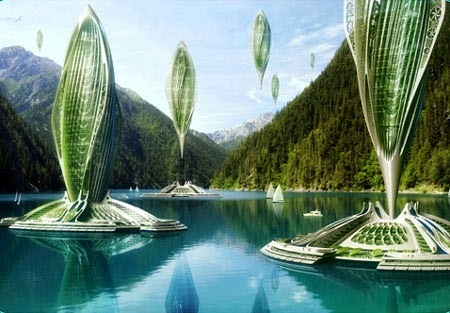 Hydrogenase by Vincent CallebautIt’s July 2030. You are heading to Vancouver Island to deliver a presentation to the International Community Planning Committee in Victoria on your innovative biomimetic design for an organic self-organized wellness centre and recreation complex in Sydney.
Hydrogenase by Vincent CallebautIt’s July 2030. You are heading to Vancouver Island to deliver a presentation to the International Community Planning Committee in Victoria on your innovative biomimetic design for an organic self-organized wellness centre and recreation complex in Sydney.You walk down the hill toward Horseshoe Bay to the nearest Hydrogenase Hub , where you are meeting with your team to discuss the presentation. The hub is a floating algal farm. The farm and the elongated seed-shaped airship docked at its centre both produce biofuel—essentially hydrogen—from the microorganism Chlamydomonas reinhardtii. Your mom, a former environmental consultant and algal scientist—now she writes science fiction—explained to you that this unicellular organism has both plant and animal properties; it carries out photosynthesis but is also heterotrophic (able to use organic carbon to grow) and will in the absence of oxygen produce gaseous hydrogen and metabolites such as formate and ethanol through hydrogenase enzymes. Chlamydomonas reinhardtiiwas first discovered as a clean source of hydrogen back in 1939 by German scientist Hans Gaffron at the University of Chicago (ironically the same year Germany invaded Poland). Gaffron called it “photosynthetic hydrogen production by algae”; and today it is a process that produces electricity and biofuel with zero emissions.
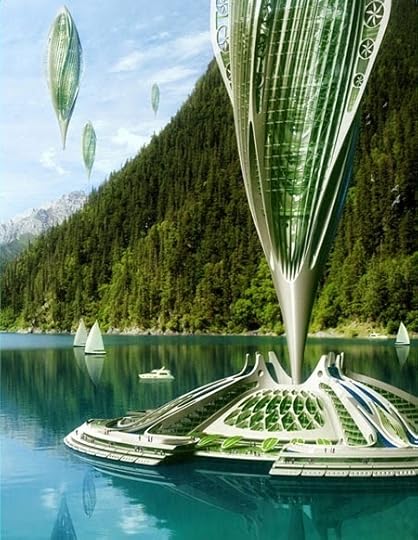 Hydrogenase by Vincent Callebaut
Hydrogenase by Vincent Callebaut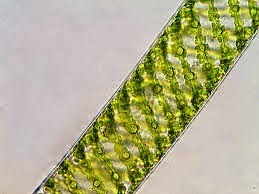 freshwater alga SpirogyraThe algae farm recycles CO2 for the bio-hydrogen airship you will be boarding after your meeting in the hub. You enter the airy station, whose honeycomb circular design resembles a stylized lily pad and glance up through the high nano-glass ceiling toward the elongated seed-shaped transport rising ten stories above you. The sun glances off the diaphanous double helix frame that resembles a freshwater spirogyra. The hub you’re standing in is a floating algae farm with solar cells on top and hydro-turbines below to capture tidal energy.
freshwater alga SpirogyraThe algae farm recycles CO2 for the bio-hydrogen airship you will be boarding after your meeting in the hub. You enter the airy station, whose honeycomb circular design resembles a stylized lily pad and glance up through the high nano-glass ceiling toward the elongated seed-shaped transport rising ten stories above you. The sun glances off the diaphanous double helix frame that resembles a freshwater spirogyra. The hub you’re standing in is a floating algae farm with solar cells on top and hydro-turbines below to capture tidal energy.The concept is the “subversive architecture” of Belgian architect Vincent Callebaut and inspired by the principles of biomimicry , coined by Janine Benyus in 2002 in her book “Biomimicry: Innovation Inspired by Nature”. Callebaut conceived Hydrogenase in 2010 as a 100% self-sufficient and zero-emission transport system using algae. He claimed that a hectare of seaweeds could produce 120 times more biofuel than a hectare of colza, soya or sunflower without consuming land needed for crops or forests. He called Hydrogenase a true miniature biochemical power station. Able to absorb CO2 as the main nutrient through photosynthesis the algae, under anaerobic conditions, produce hydrogen in vitro or in bioreactors.
 Hydrogenase by Vincent CallebautYou swipe your PAL over the ticket booth sensor and the optional ticket-brochure pops out. You take it and read the specs between glances at the tall vessel loading in the dock of the hub. It’s really like a vertical dirigible, you think, studying the seed-shaped airship with self-cleaning “intelligent” nanostructured glass—inspired by the lotus leaf that doesn’t get wet. The semi-rigid unpressurised airship stretches vertically around an arborescent spine that twists like chloroplast ribbons 400 meters high and 180 meters in diameter.
Hydrogenase by Vincent CallebautYou swipe your PAL over the ticket booth sensor and the optional ticket-brochure pops out. You take it and read the specs between glances at the tall vessel loading in the dock of the hub. It’s really like a vertical dirigible, you think, studying the seed-shaped airship with self-cleaning “intelligent” nanostructured glass—inspired by the lotus leaf that doesn’t get wet. The semi-rigid unpressurised airship stretches vertically around an arborescent spine that twists like chloroplast ribbons 400 meters high and 180 meters in diameter.You read that each Hydrogenase airship is covered with flexible inflatable photovoltaic cells and twenty wind turbines to maneuver and collect energy. The interior spaces provide room for housing, offices, scientific laboratories, and entertainment, and a series of vegetable gardens that provide a source of food while recycling waste. You read that this self-sufficient organic transport flies about 2000 meters high at about 175 km/hr (twice the speed of a conventional ship). Given its ease in negotiating airspace and its ability to land and take off from virtually any location, the Hydrogenase is used by many groups in various capacities. Your friend Michael who teaches at the University of Victoria uses one as a mobile research station in his studies along the coast of northern British Columbia.
 Inside the Hydrogenase "balloon"
Inside the Hydrogenase "balloon"The vessel is made of “intelligent layers” and “self-separable ceramics”. Its bionic coating draws inspiration from sharkskin that is self-cleaning and flow-efficient. You head down the spiral staircase to the third subsea level toward the meeting room you booked earlier on your PAL. The view is spectacular from here through the nano-glass panes. Rays of shimmering light stream through a gently swaying forest of kelp. You glimpse the sun-glinted flickering of hundreds of anchovies as they school through the kelp. This floating farm is an organic purifying station of four carbon wells where the algae recycle the carbonated waste brought by the airships and, in turn, feed the airship with biohydrogen. It’s the new “gas station”, you reflect with a smile.
 top and bottom views of HydrogenaseAfter your meeting with staff, you and three others of your team board the airship and settle in one of the skyview chambers. The journey is relaxing, like the BC Ferry used to be, but without the pungent smell and pollution of conventional motorized sea vessels. It’s a quiet and relaxing trip with a spectacular view of the Gulf Islands. Your team strategizes your presentation over a light lunch and Matcha lattes. The PA system sounds and a woman’s voice informs you that the ship will be making an emergency landing on Saturna Island to rescue two hikers injured at East Point. This will only add twenty minutes to the trip, the woman assures you. You don’t mind and recall the disclaimer at the bottom of the ticket. Given the ability of this airship to take off and accurately land virtually anywhere, all Hydrogenases are by law mandated to be on standby for rescue missions in rough terrain.You pull out the ticket and read again: The Hydrogenase is affiliated with the International Red Cross and BC Coastguard. The Hydrogenase must by law respond to any distress call at sea or rough terrain associated with coastal waters. Because of this service, we cannot guarantee a timely schedule.
top and bottom views of HydrogenaseAfter your meeting with staff, you and three others of your team board the airship and settle in one of the skyview chambers. The journey is relaxing, like the BC Ferry used to be, but without the pungent smell and pollution of conventional motorized sea vessels. It’s a quiet and relaxing trip with a spectacular view of the Gulf Islands. Your team strategizes your presentation over a light lunch and Matcha lattes. The PA system sounds and a woman’s voice informs you that the ship will be making an emergency landing on Saturna Island to rescue two hikers injured at East Point. This will only add twenty minutes to the trip, the woman assures you. You don’t mind and recall the disclaimer at the bottom of the ticket. Given the ability of this airship to take off and accurately land virtually anywhere, all Hydrogenases are by law mandated to be on standby for rescue missions in rough terrain.You pull out the ticket and read again: The Hydrogenase is affiliated with the International Red Cross and BC Coastguard. The Hydrogenase must by law respond to any distress call at sea or rough terrain associated with coastal waters. Because of this service, we cannot guarantee a timely schedule.
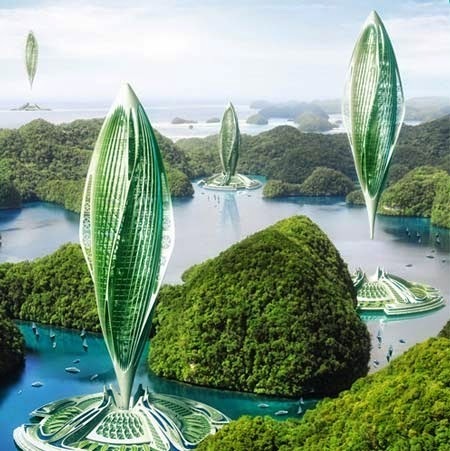 Hydrogenase hub algal farms and airshipsYou recall how Hydrogenases were deployed in the last hurricane disaster off the coast of Florida last year, saving countless people trapped in the flooding that accompanied the storm. The International Red Cross uses them as flying hospitals.
Hydrogenase hub algal farms and airshipsYou recall how Hydrogenases were deployed in the last hurricane disaster off the coast of Florida last year, saving countless people trapped in the flooding that accompanied the storm. The International Red Cross uses them as flying hospitals.Bernard frets over the time delay. He is concerned about the lack of preparation and set up time once you get into Victoria. You assuage him gently. The best preparation is sincerity, you tell him. The landscape architect Thomas Woltz whose work you highly respect, saw himself as someone who embraces the complexity of modern life while seeking meaning and narrative in both natural and man-made environments.
 Hydrogenase by Vincent Callebaut“We’re storytellers,” you tell Andre. Invoking metaphor through design. “They know we’re coming and they know we’re helping someone; they’ll wait for our story. And it’s all about harmony.”
Hydrogenase by Vincent Callebaut“We’re storytellers,” you tell Andre. Invoking metaphor through design. “They know we’re coming and they know we’re helping someone; they’ll wait for our story. And it’s all about harmony.”The lines of Henry David Thoreau come to you: Man’s life must be of equal simplicity and sincerity with nature, and his actions harmonize with her grandeur and beauty.
Then you point your PAL at the ServiceBot and order three more lattes. You lean back in your bamboo fabric chair and cross your legs over the leg rest.
It’s a new world.
 Kevin Klassen grabs a bite in Victoria Harbour
Kevin Klassen grabs a bite in Victoria Harbour
Published on July 19, 2014 18:04
July 15, 2014
Tesla, Frequency, Vibration and Bioresonance Healing Therapy
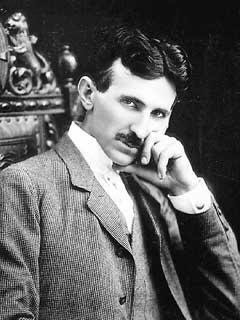 Nikola TeslaIf you want to find the secrets of the universe, think in terms of energy, frequency and vibration—Nikola Tesla
Nikola TeslaIf you want to find the secrets of the universe, think in terms of energy, frequency and vibration—Nikola TeslaEverything in life is vibration—Albert Einstein
The natural frequency of an object is associated with one of its many “standing wave patterns” by which it vibrates. The natural frequencies of a musical instrument are sometimes referred to as the harmonics of the instrument. An instrument can be forced into vibrating at one of its harmonics (with one of its standing wave patterns) if another interconnected object pushes it with one of those frequencies. This is resonance: when a second object vibrating at the same natural frequency as the first object forces it into vibrational motion. A common example is pushing someone on a swing. The Bay of Fundy experiences tidal resonance. Acoustic resonance can occur between a musical instrument and a human vocal cord. A crystal wineglass will shatter when exposed to a musical tone of the right pitch (its resonant frequency). Electrical resonance of tuned circuits in radios occurs when a certain radio frequency is received. Orbital resonance occurs when two orbiting bodies—like two moons or two planets (e.g., Neptune and Pluto)—exert a regular, periodic gravitational influence on each other.
Most vibrating objects have multiple resonant frequencies.
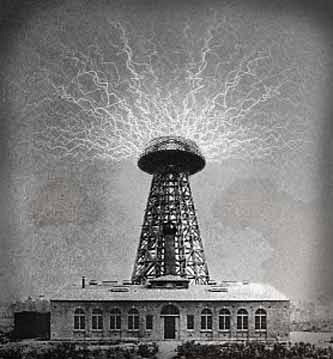 the Tesla Tower at Wardenclyffe
the Tesla Tower at WardenclyffeInventor and Engineer August Worley tells us that “resonance occurs when two or more tuned frequency systems interact in such a way as to induce an energetic transfer.”
Schumann Resonance (SR) is the global electromagnetic resonance that occurs as a set of peaks in the extremely low frequency (ELF) portion of the Earth’s electromagnetic field spectrum between 3 and 69 Hz, with distinct peaks at 7.83, 14.3, 20.8, 27.3 and 33.8 Hz. SR acts as a closed waveguide. It’s like a wave-bridge.
“So astounding are the facts in this connection,” said Nikola Tesla in 1899 of the Earth’s electromagnetic resonance—later named Schumann Resonance in 1954, “that it would seem as though the Creator, Himself had electrically designed this planet.”
 "Tesla Towers" in Istra near MoscowThe normal standing wave created in the Schumann Cavity occurs at a wavelength equal to the circumference of the Earth, and at a base frequency (and highest intensity) of between 6-8 Hz (7.83 Hz). Some call this basic frequency the Earth’s “heartbeat” or the “tuning fork” of the planet, suggesting that it generates natural healing properties when living things are entrained to its rhythm. It turns out that all biological systems resonate at this same frequency range. The electrical resonance of the Earth lies between 6-8 Hz. This coincides with alpha rhythms produced by the human brain during meditation, relaxation and creativity. Dolphins produce sound waves that coincide with the Schumann Resonance Frequency of 7.83 Hz. According to the AquaThought Foundation, human contact with dolphins induces both alpha brain state and hemispheric synchronization in the brain. Dr. H. König, Schumann’s successor at Munich University, discovered that the dominant brain wave rhythm of all mammals is the alpha or resting state of 6-8 Hz.
"Tesla Towers" in Istra near MoscowThe normal standing wave created in the Schumann Cavity occurs at a wavelength equal to the circumference of the Earth, and at a base frequency (and highest intensity) of between 6-8 Hz (7.83 Hz). Some call this basic frequency the Earth’s “heartbeat” or the “tuning fork” of the planet, suggesting that it generates natural healing properties when living things are entrained to its rhythm. It turns out that all biological systems resonate at this same frequency range. The electrical resonance of the Earth lies between 6-8 Hz. This coincides with alpha rhythms produced by the human brain during meditation, relaxation and creativity. Dolphins produce sound waves that coincide with the Schumann Resonance Frequency of 7.83 Hz. According to the AquaThought Foundation, human contact with dolphins induces both alpha brain state and hemispheric synchronization in the brain. Dr. H. König, Schumann’s successor at Munich University, discovered that the dominant brain wave rhythm of all mammals is the alpha or resting state of 6-8 Hz. When two vibrating systems resonate with each other, like the human brain and the global electric circuit, a rise in amplitude in the waves occurs. They are said to be in tune. They are resonating. Proponents suggest that a rise in amplitude causes a rise in our consciousness energy and that Schumann Resonance generates healing effects when living things are entrained to its frequency.
 The Tesla coil in Colorado Springs
The Tesla coil in Colorado SpringsNikola Teslacertainly understood this when he intuited that energy waves in the earth and the atmosphere could be used to transmit power to any point on the globe. He understood that the surface of the Earth, the ionosphere and the atmosphere together form one gigantic electrical circuit—an electrified Gaia, so to speak—and this formed the basis for his work on wireless energy transmission. Tesla was able to transmit power and energy wirelessly over long distances (via transverse waves and longitudinal waves). He transmitted extremely low frequencies (ELF) through the ground and between the Earth’s surface and the Kennelly-Heaviside layer of the ionosphere. Tesla patented wireless transceivers that developed standing waves and it was he who discovered that the resonant frequency of the Earth was about 8 Hz and in the range of the Schumann Resonance or Cavity.
Modern technology appears to be threatening humanity’s connection with earth’s fundamental frequency and the natural vibrations of Schumann Resonance. Threats include artificial man-made EMF radiation, wireless technology, and high frequency heating microwaves pulsed at 2.45 GHz. Whether we co-evolved with Earth’s natural electromagnetic environment or were created with Divine Intelligence to live in harmony with it, many experts believe that artificial man-made EMF radiation masks the natural beneficial frequency of the Earth and may create an environment that is literally `out of tune' with Nature itself.
 Jenny sand
Jenny sandCymatics, Evolution and the Power of Sound
A while back I wrote an article entitled “the Mozart Effect: The Power of Music” in which I discussed how music can heal the body, strengthen the mind and unlock the creative spirit. For instance, music with a pulse of about sixty beats per minute can shift consciousness from the beta wave (ordinary consciousness at 14-20 Hz) toward the alpha range (heightened awareness at 8-13 Hz), enhancing alertness and general well-being.
 A film of turpentine subjected to sound wavesThe study of cymatics, coined by Hans Jenny from the Greek word kyma (wave), explores how sound affects gases, liquids, plasmas and solids and how vibrations, in the broad sense, generate and influence patterns, shapes and moving processes. When sound travels through non-solids it moves in longitudinal waves called compression waves. In matter, the medium is displaced by sound waves, causing it to oscillate at a frequency relative to the sound, and visible patterns emerge.
A film of turpentine subjected to sound wavesThe study of cymatics, coined by Hans Jenny from the Greek word kyma (wave), explores how sound affects gases, liquids, plasmas and solids and how vibrations, in the broad sense, generate and influence patterns, shapes and moving processes. When sound travels through non-solids it moves in longitudinal waves called compression waves. In matter, the medium is displaced by sound waves, causing it to oscillate at a frequency relative to the sound, and visible patterns emerge.Jenny was convinced that biological evolution was a result of vibrations, and that their nature determined the ultimate outcome. He speculated that every cell has its own frequency and that a number of cells with the same frequency create a new frequency, which is harmonious with the original, which in its turn possibly formed an organ that also created a new frequency in harmony with the two preceding ones. Jenny was saying that the key to understanding how we can heal the body with the help of tones lies in our understanding of how different frequencies influence genes, cells and various structures in the body.
 Ancient Hebrew
Ancient HebrewExtending his tonoscope research into voice and language, Jenny discovered that when the vowels of ancient Hebrew and Sanskrit were pronounced, the sand took the shape of the written symbols for these vowels, while modern languages didn’t generate the same result. This has led spiritual philosophers to ponder if “sacred languages” (including Tibetan and Egyptian) have the power to influence and transform physical reality, to create things through their inherent power, or through the recitation or singing of sacred texts, to heal a person who has gone "out of tune"?
Physioacoustics and Healing BioResonance with the Pyradym
 Tibetan Monks chantingSince ancient times, low frequency sound was used in various forms to cause physiological and psychological effects. From the chant of Tibetan monks, to the Gregorian chant, to the Music of African tribes, and Australian aborigines; low frequency sound was used to calm, to excite, to relieve anxiety, to motivate warriors, and to induce relaxation. Physioacoustics is a scientific method of applying low frequency stimulation to the human body to obtain desired emotional or physical effects. Physioacoustics may be thought of as the science that takes the active ingredients out of music, concentrates them, and infuses them in pure form to motivate or heal.Researchers in Physioacoustics use sound waves in the frequency range of 27 to 113 Hz. Most research in Low Frequency Sound has been carried out in Scandinavia, England, and other parts of Europe . Since 1991 controlled studies in North America have demonstrated significant decreases in anxiety, tension, muscle spasticity, arousal states, and dramatic increases in relaxation and a sense of well-being.
Tibetan Monks chantingSince ancient times, low frequency sound was used in various forms to cause physiological and psychological effects. From the chant of Tibetan monks, to the Gregorian chant, to the Music of African tribes, and Australian aborigines; low frequency sound was used to calm, to excite, to relieve anxiety, to motivate warriors, and to induce relaxation. Physioacoustics is a scientific method of applying low frequency stimulation to the human body to obtain desired emotional or physical effects. Physioacoustics may be thought of as the science that takes the active ingredients out of music, concentrates them, and infuses them in pure form to motivate or heal.Researchers in Physioacoustics use sound waves in the frequency range of 27 to 113 Hz. Most research in Low Frequency Sound has been carried out in Scandinavia, England, and other parts of Europe . Since 1991 controlled studies in North America have demonstrated significant decreases in anxiety, tension, muscle spasticity, arousal states, and dramatic increases in relaxation and a sense of well-being.
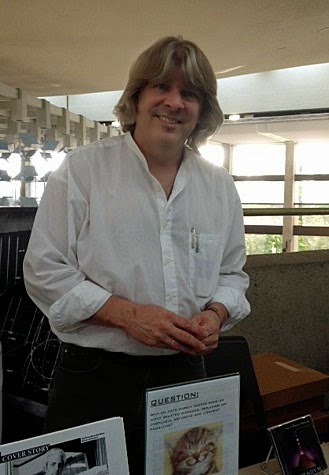 August Worley at Teslamania TorontoI recently attended a festival dedicated to Nikola Tesla on his 158th birthday at the Science Centre in Toronto. While I was there, I met August Worley, inventor of the Pyradym, a sound-healing instrument that uses the principals of physioacoustics. Shaped in the form of a pyramid, the self-contained electrically powered apparatus helps stimulate and facilitate the human body’s own self-healing.
August Worley at Teslamania TorontoI recently attended a festival dedicated to Nikola Tesla on his 158th birthday at the Science Centre in Toronto. While I was there, I met August Worley, inventor of the Pyradym, a sound-healing instrument that uses the principals of physioacoustics. Shaped in the form of a pyramid, the self-contained electrically powered apparatus helps stimulate and facilitate the human body’s own self-healing. He build the bio-resonating Pyradym because, “it just seems logical to me that having a convenient and interactive way of treating our bodies to harmonious resonant frequencies can go a long way towards correcting some of the damage induced by our toxic environment. Consider the “envelope of frequency hash” being generated in our hostile electromagnetic environment. I believe we underestimate the refractory impact the EMFs being generated in our technologically-based societal environment is having to our immune systems, aside from what we ingest.”
 Worley demonstrates the PyradymIn a 2007 interview with Asheville reporter Bill Brackney, Worley revealed that, “a few years ago a widely circulated surveypublished the average life spans of people in various occupational groups. “Experts” were surprised to find that orchestral conductors were the longest-lived occupation in the survey. I read that and thought ‘why wouldn’t this be so?’ Aside from the obvious aspect of the aerobic activity of the involved upper body movement, they are being regularly washed at the cellular level in a shower of pure, harmonious resonant frequencies being generated right in front of them! In fact – they are essentially the focal point of all of the sound being generated by the orchestra, aren’t they?!”
Worley demonstrates the PyradymIn a 2007 interview with Asheville reporter Bill Brackney, Worley revealed that, “a few years ago a widely circulated surveypublished the average life spans of people in various occupational groups. “Experts” were surprised to find that orchestral conductors were the longest-lived occupation in the survey. I read that and thought ‘why wouldn’t this be so?’ Aside from the obvious aspect of the aerobic activity of the involved upper body movement, they are being regularly washed at the cellular level in a shower of pure, harmonious resonant frequencies being generated right in front of them! In fact – they are essentially the focal point of all of the sound being generated by the orchestra, aren’t they?!”“Resonance,” says Worley, “is a metaphor for the energetic expression of the Universe at its most fundamental level.”
We are a gestalt culmination of light, wave-pulse, matter and motion resonating with this beloved planet Earth and its water. Our minds and bodies “sing” its choral aria. I’ve heard it. Have you?
You can learn more about August Worley and the Pyradym at www.Pyradym.com.
Relevant Articles of Interest:
Rupert Sheldrake and the Physics of Angels
The Mozart Effect: the Power of Music
Cymatics: Exploring How Frequency Changes the VeryNature of Matter and Energy
What Do the Planet Earth, the Human Brain andSchumann Resonance Have in Common?
Published on July 15, 2014 20:28
July 11, 2014
The Angel of Verdun and The Edge of Tomorrow
 Rita Vrataski (Emily Blunt)She’s called The Angel of Verdun. You also see another name scrawled in bright red over a London bus: Full Metal Bitch. When we first see her, angry and fierce in her battle gear (which resembles a modern-day knight’s armour) she’s heading out to battle, stomping out of the bunker, surrounded by an entourage, and summarily knocks an acolyte down who gets in her way. She’s badass. She’s the Full Metal Bitch.Her real name is Rita Vrataski. She wields a sharpened helicopter blade as her weapon of choice and serves as the poster girl for the United Defense Force to recruit more into the fight.
Rita Vrataski (Emily Blunt)She’s called The Angel of Verdun. You also see another name scrawled in bright red over a London bus: Full Metal Bitch. When we first see her, angry and fierce in her battle gear (which resembles a modern-day knight’s armour) she’s heading out to battle, stomping out of the bunker, surrounded by an entourage, and summarily knocks an acolyte down who gets in her way. She’s badass. She’s the Full Metal Bitch.Her real name is Rita Vrataski. She wields a sharpened helicopter blade as her weapon of choice and serves as the poster girl for the United Defense Force to recruit more into the fight.Rita (Emily Blunt) is a very different kind of poster girl for the war effort of the recent SF action
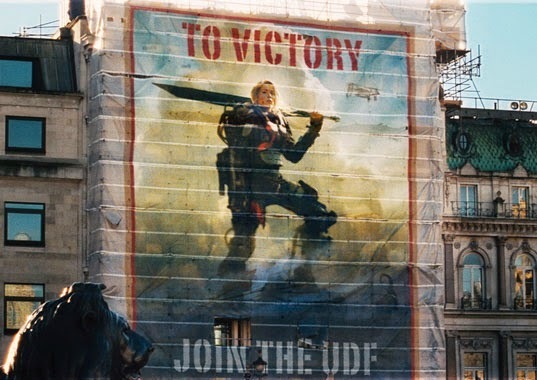 movie
Edge of Tomorrow
, directed by Doug Liman and written by Christopher McQuarrie. There is an “edge of tomorrow” in this military SF story that explores how much we’ve changed since the time of World War I and II. And that change is most apparent in how women are seen and act.
movie
Edge of Tomorrow
, directed by Doug Liman and written by Christopher McQuarrie. There is an “edge of tomorrow” in this military SF story that explores how much we’ve changed since the time of World War I and II. And that change is most apparent in how women are seen and act. Edge of Tomorrow makes subtle and not so subtle reference to both world wars: from its June 6th release (70thanniversary of D-Day and the massive and decisive Normandy landing) to its reference to the trenches of Verdun in WWI, the Nazi or German Empire forces as the original seat of the Omega entity and many more.
 The premise is straight-forward science fiction stuff: Earth is under attack by an alien species, who have seeded themselves with a meteor shower. The aliens have conquered Russia and China and now threaten France and England. Evoking echoes of World War II’s Normandy invasion, the United States joins the fray in support of their allies.
The premise is straight-forward science fiction stuff: Earth is under attack by an alien species, who have seeded themselves with a meteor shower. The aliens have conquered Russia and China and now threaten France and England. Evoking echoes of World War II’s Normandy invasion, the United States joins the fray in support of their allies.American Major William Cage (Tom Cruise), who is with the PR staff of the war effort, gets unwillingly drafted to the front as a rookie private and dies in the first five minutes of landing on the shores of Normandy—but not before he kills an alpha alien, which covers him in blue blood. This sends him into a vicious time loop, where he must relive and die over and over in that horrendous bloodbath. Each time, he glimpses the Angel of Verdun repeatedly killed. On one occasion, Vrataski runs across him, lying injured in the mud. He can’t move, sure victim to the aliens.
 She snatches his battery pack and moves on, leaving him there to die. Astonished at the Angel’s apparent lack of compassion, Cage will later mimic her “let him die” attitude when he knowingly lets fellow soldier Kimmel get crushed.
She snatches his battery pack and moves on, leaving him there to die. Astonished at the Angel’s apparent lack of compassion, Cage will later mimic her “let him die” attitude when he knowingly lets fellow soldier Kimmel get crushed.
 WW2 Pin up girl
WW2 Pin up girlIn a later iteration he finally meets Vrataski on the battlefield, where she realizes (having gone through the time loop and lost it) that he is now in a time loop and therefore the key to their victory; she tells him to find her when he wakes up just seconds before she lets herself get blown up and they begin their looping journey together. To his complaint, “I’m not a soldier,” Vrataski replies, “No, you’re a weapon.” That’s how she sees him. And to that end, she mentors him in the art and science of soldiering. When things go awry she time and again unflinchingly shoots him dead to reset the time. Cage tries to engage her in casual conversation and finds her taciturn. “You don’t talk much,” he observes, to which she quips, “Not a fan.” She’s all about the business of defeating the enemy before the human race is wiped out.
 Edge of Tomorrow
provides a refreshing kind of woman hero; someone who is equal to her male protagonist in skill, intelligence and heroic stature. What I mean by heroic stature is that her heroic journey of transformation does not play subservient to her male counterpart’s journey. This almost happens on two occasions when Cage gives her an “out” to stay behind and let him take over. She declines. In fact, Cruise lets her character take the lead, even though this it truthfully Cage’s story of metaphoric transformation from “onlooker” to “participant”.
Edge of Tomorrow
provides a refreshing kind of woman hero; someone who is equal to her male protagonist in skill, intelligence and heroic stature. What I mean by heroic stature is that her heroic journey of transformation does not play subservient to her male counterpart’s journey. This almost happens on two occasions when Cage gives her an “out” to stay behind and let him take over. She declines. In fact, Cruise lets her character take the lead, even though this it truthfully Cage’s story of metaphoric transformation from “onlooker” to “participant”.In so many androcratic storylines, the female—no matter how complex, interesting and tough she starts out being—must demure to the male lead; as if only by bowing down to his superior abilities can she help ensure his heroic stature. Returning us right back to the cliché role of the woman supporting the leading man to complete his hero’s journey. And this often means serving as the prize for his chivalry. We see this in so many action thrillers and action adventures today: Valka in How to Train Your Dragon, Wyldstyle in The Lego Movie, Neytiri in Avatar, Trinity in The Matrix, and so many more. There’s even a name for it: the Trinity Syndrome.
Tasha Robinson writes in her excellent article entitled, We’re losingall our Strong Female Characters
 to Trinity Syndrome: “The idea of the Strong Female Character—someone with
her own identity, agenda, and story purpose
—has thoroughly pervaded the conversation about what’s wrong with the way women are often perceived and portrayed today, in comics, video-games, and film especially…it’s still rare to see films in the mainstream action/horror/science-fiction/fantasy realm introduce women with any kind of meaningful strength, or women who go past a few simple stereotypes.”
to Trinity Syndrome: “The idea of the Strong Female Character—someone with
her own identity, agenda, and story purpose
—has thoroughly pervaded the conversation about what’s wrong with the way women are often perceived and portrayed today, in comics, video-games, and film especially…it’s still rare to see films in the mainstream action/horror/science-fiction/fantasy realm introduce women with any kind of meaningful strength, or women who go past a few simple stereotypes.”I give Cruise, Liman and McQuarrie full marks for not doing this. For example, after Cage makes his case to his Squadron to go find the Omega in Paris, they remain reluctant until Vrataski emerges. “I don’t expect you to follow me,” says Cage. “I do expect you to follow her.” The Angel of Verdun—or better yet, the badass Full Metal Bitch. And why not? Who wouldn’t follow her?
 Is this one of the reasons that this movie didn’t do so well in the North American box office as it did overseas, whose audience may reflect a more mature, open and enlightened audience?
Is this one of the reasons that this movie didn’t do so well in the North American box office as it did overseas, whose audience may reflect a more mature, open and enlightened audience? When a female lead is stronger than the male protagonist, some reviewers (OK—male reviewers) treat and categorize that movie as a “woman’s story”. I’ve been told by some of my male friends that they couldn’t possibly empathize with such a character—mainly because she is a woman and she is stronger than the male lead “they want to be”. Invariably, in many of these, the male counterpart is so much “milk-toast” compared to that awesome female-warrior. And have you ever noticed that, while the male hero gets the girl, the female hero usually ends up alone? Great examples include: Buffy the Vampire Slayer; Xena: Warrior Princess; Sarah in The Terminator and of course Vasquez in Aliens. These women are amazons; they stand apart, goddess-like, unrelenting, unflinching—untouchable. It’s actually no wonder that my ex-husband dislikes Sigourney Weaver to this day—she could crush him underfoot and eat him for breakfast at a moment’s notice. And probably would!
In a superb article in NewStatesman entitled I hate Strong Female Characters , Sophia McDougall
 says:
says:“…I want to point out two things that Richard (the II) has, that Bond and Captain America and Batman also have, that Peggy (Carter of Captain America), however strong she is, cannot attain. They are very simple things, even more fundamental than “agency”.
1) Richard has the spotlight. However weak or distressed or passive he may be, he’s the main goddamn character.
2) Richard has a huge range of other characters of his own gender around him, so that he never has to act as any kind of ambassador or representative for maleness. Even dethroned and imprisoned, he is free to be uniquely himself.On the posters [women are] posed way in the back of the shot behind the men, in the trailers they may pout or smile or kick things, but they remain silent. Their strength lets them, briefly, dominate bystanders but never dominate the plot. It’s an anodyne, a sop, a Trojan Horse - it’s there to distract and confuse you, so you forget to ask for more.”
 There is another type of female hero. She is equalto her male counterpart. Her story is not secondary to his story; her heroic status and hero’s journey is equal to his; in fact they may share the same journey. Examples include: Bonnie and Clyde; Peter Chang’s Aeon Flux;
Farscape
; Battlestar Galactica…
There is another type of female hero. She is equalto her male counterpart. Her story is not secondary to his story; her heroic status and hero’s journey is equal to his; in fact they may share the same journey. Examples include: Bonnie and Clyde; Peter Chang’s Aeon Flux;
Farscape
; Battlestar Galactica…And now Edge of Tomorrow .
As with the above examples, Vrataski and Cage form a team, in which together they are more than the sum of their parts. A marriage of independent autopoiesis, combining skills, abilities and vision. This is also why, in my opinion, the ending of Edge of Tomorrow is totally appropriate: not because it’s “the happy ending”; but because it carries the message of enduring collaboration of equals in a gylanic society.
Other Relevant Articles of Interest:
Spiritual Ecology and the Lesson of Crete
The Western Woman Will Save the World
Gaia versus Medea: A Case for Altruism
Female Heroes in Literature and Pop Culture
Gylany: a social system based on equality of men and women
Androcracy: a form of governing system in which rulers are male
Riane Eisler (in The Chalice and the Blade) provides examples of sociobiologists who draw on nineteenth-century Darwinism by citing insect societies to support their androcratic (social and political rule by men) theories. If we are to truly rise victorious over the scourge of climate change—a function of our current lifestyle and paradigms—we will need to adopt a cultural evolution that embraces a partnership society heralded by new and renewed symbology, language and “myth”.
Published on July 11, 2014 15:46
July 3, 2014
Embracing Your Future: the EBM...
 Those who are inspired by a model other than Nature, a mistress above all masters, are laboring in vain
—Leonardo daVinci
Those who are inspired by a model other than Nature, a mistress above all masters, are laboring in vain
—Leonardo daVinciYou pause at the front door of the eco-house that you and your partner designed in Vancouver’s Point Grey and pull up the collar of your jacket. The air is fresh with the promise of snow and you smile with thoughts of spring skiing at Whistler.
You glance at the time display on your Smart Glasses. You’ve decided to forego the WaveGate and walk to the café; you have plenty of time to walk through the hilly forested streets, with a view of English Bay. You want to check out the refurbished solar-house on Locarno Crescent that your company helped design. Based on a living model of Biomimicry , the house is the latest iteration of your company’s “symbiosis” model of 100% sustainability, in which people live in a cooperative and synergistic partnership with their environment. The house is an intelligent organic facility with self-cleaning floors and walls; heated, fuelled and lit by organisms in a commensal relationship. Everything works on a natural cycle of harmonious renewal and natural evolution. You smile, rather self-pleased. It has taken you a few years to convince the city council to accept this new model in community design. Now, it’s happening everywhere.

It’s April 12, 2074. A special day. And a special year. The year of the wooden horsein the Chinese calendar. Also called the green horse, it’s associated with spring, growth and vitality. The horse symbolizes nobility, class, speed and perseverance. Horse energy is pure unbridled spirit. Playful, wild and independent, the horse has a refined instinct that flows through action and movement. Together, these symbols promise both chaos and great opportunity. And transformation.
 The year of the wooden horse only occurs every sixty years. And sixty years ago today your mom turned sixty. You release a boyish grin at what you intend to do in celebration. On that day, sixty years ago, she celebrated her sixtieth birthday with the release of
Natural Selection
, her collection of speculative short stories about human evolution, AI, genetic manipulation, transhumanism, and the human-‘machine’ interface. She also celebrated the local printing of
Metaverse
, the third book of her space detective trilogy,
The Splintered Universe
. It was the second book to be printed by Toronto Public Library’s newly acquired Espresso Book Machine; one of only two EBMs in Toronto at the time.
The year of the wooden horse only occurs every sixty years. And sixty years ago today your mom turned sixty. You release a boyish grin at what you intend to do in celebration. On that day, sixty years ago, she celebrated her sixtieth birthday with the release of
Natural Selection
, her collection of speculative short stories about human evolution, AI, genetic manipulation, transhumanism, and the human-‘machine’ interface. She also celebrated the local printing of
Metaverse
, the third book of her space detective trilogy,
The Splintered Universe
. It was the second book to be printed by Toronto Public Library’s newly acquired Espresso Book Machine; one of only two EBMs in Toronto at the time.A smile slants across your face as you remember what libraries and bookstores used to look like then. Both were struggling with a changing paradigm of reading, writing and publishing. Many of the older folk feared that books—print books, particularly—were going extinct as more exciting channels of communication like videos, interactive games and instant social networking took over. Of course, that didn’t happen. “Story” and “storytelling” were simply evolving and the paradigm shift simply embraced a new model that incorporated more diverse expression. You remember conversations with your mom about Chapters-Indigo, whose face changed from a bookstore to a gift store and tchotchke filled more and more of the storefront. As large bookstores struggled to dominate, the EBM—like its lithe mammal cousins in the Cenozoic Era—created a new niche for itself: the book ATM.

The size of a Smart Car, the EBM could fit nicely in a stylish café, housing and dispensing—Tardis-style—many more books than its diminutive size. In 2014, the EBM carried over eight million titles, including commercial books and out-of print gems. That number has tripled as virtually every publisher has embraced the Book ATM model to sell books.
You inhale the tantalizing aroma of freshly ground and brewed coffee before you reach Zardoz Café. The retro-style café is a converted Edwardian-style house with high arched windows and a living roof overlooked by tall sycamore trees. You climb the stairs and enter the café. Its 2020’s style interior that your company helped design is decorated in earthy tones, avant-garde art, a forest of dracaenas and ferns and a stepped creek, complete with goldfish and crayfish. A shiny brass Elektra Belle Epoque espresso maker sits at the bar, dispensing the finest fair trade coffee.
 Your sweeping gaze notes several people at the small round tables, enjoying good coffee and conversation; your special guest hasn’t arrived yet. You spot the WaveGate at the back, resembling an old English police box. Next to it sits the EBM. Eager to do your deed before your guest arrives, you sidle to the coffee bar and catch Grace’s eye. She smiles; you’re a regular. You touch her wrist with your watch and the data passes onto her embedded interface. She taps her hand to process the book order—she insists that you not pay—then she makes your double-shot espresso—the old-fashioned way. As she grinds and taps and runs the machine, you and she chat about skiing this spring. Just as Grace hands you a perfect crema-topped espresso, the WaveGate shimmers briefly and then its doors open like an accordian.
Your sweeping gaze notes several people at the small round tables, enjoying good coffee and conversation; your special guest hasn’t arrived yet. You spot the WaveGate at the back, resembling an old English police box. Next to it sits the EBM. Eager to do your deed before your guest arrives, you sidle to the coffee bar and catch Grace’s eye. She smiles; you’re a regular. You touch her wrist with your watch and the data passes onto her embedded interface. She taps her hand to process the book order—she insists that you not pay—then she makes your double-shot espresso—the old-fashioned way. As she grinds and taps and runs the machine, you and she chat about skiing this spring. Just as Grace hands you a perfect crema-topped espresso, the WaveGate shimmers briefly and then its doors open like an accordian. Your mom emerges from the “tardis”, smartly dressed in an early-century blazer and skirt, and grinning like an urchin. She resembles the seventeenth Doctor a bit, you decide—the first female Doctor Who, finally! Somehow—you don’t know how she does it—her old-fashioned style manages to embrace “retro-cool”. She’s arrived from Switzerland, where she is house and cat-sitting for good friends in Gruyeres. From there she still commutes—Tardis-style—as sessional lecturer at the University of Toronto, where she maintains a tiny book-festooned office.
 Kevin Klassen“Kevy!” she squeals like a girl, obviously happy to see you. You don’t cringe; you’ve grown accustomed to the ripples of interest your mom’s unalloyed enthusiasm usually creates.
Kevin Klassen“Kevy!” she squeals like a girl, obviously happy to see you. You don’t cringe; you’ve grown accustomed to the ripples of interest your mom’s unalloyed enthusiasm usually creates. “Happy birthday, Mom!” You seize her in a hug. “I’m glad you made it to Vancouver for your 120thbirthday.” Traveling the WaveGate suits her, you consider.
“I like the tardis better than you, I think,” she says, smiling sideways at you with knowing. She’s right; you prefer the old-fashioned way of traveling, without having to reconfigure your molecules from one place to another. In fact, you prefer the old-fashioned way of doing a lot of things, you decide with an inner smile.
“I have a surprise for you, Mom,” you say with a knowing grin. Your mom likes surprises. Her eyes light up and she beams at you. You glance at Grace with a conspiratorial look. She takes the cue and starts the EBM.
“Over here,” you say, steering your mom toward the EBM, already humming like an old tomcat getting its chin scratched. Your mom bends down to watch the pages spew out of the paper holder and stack neatly in a tray, then get snatched by robotic fingers as a colour cover is created then laid below, ready to envelope the book interior. After the gluing and binding, the robots trim the book on three sides then summarily send it sliding out a chute on the side.
Your mom has guessed what the book is; but she still squeals with glee when she sees it. It’s Metaverse , of course; the book she first had printed on the EBM in Toronto’s Public Library sixty years ago on her birthday.
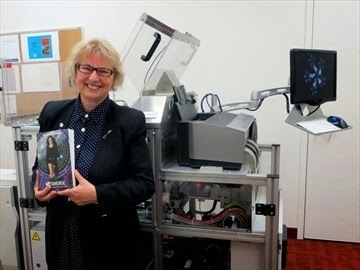 Nina Munteanu proud with Metaverse just printed on EBM
Nina Munteanu proud with Metaverse just printed on EBM“I just thought you’d like another book,” you say with a laugh. Like she needs another book. But this one’s special; it’s sixty years old today. Just like she was, sixty years ago—today. You pull out your PAL and point at your mom, as she seizes the perfectly bound book. “Let me take your picture!”
She poses with the book, looking like a kid with candy. You check the image and laugh. “There it is. You don’t look a year over sixty!” You grin at your 120-year old mother.
“And you don’t look a day over twenty-three!” she teases back.
You give her a slanted smile. You’re eighty-three.
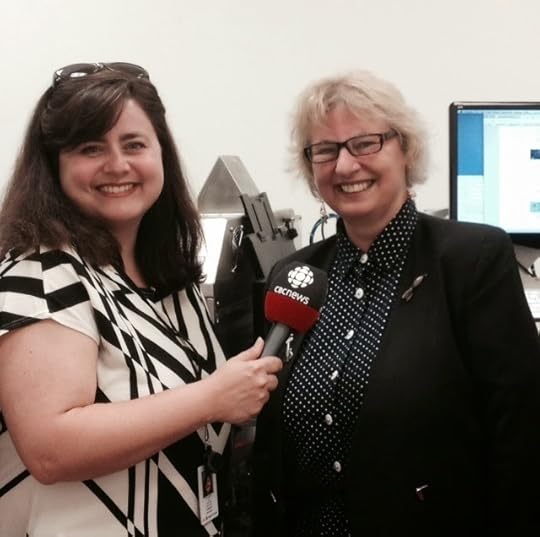 Lisa Naccarato & Nina Munteanu in 2014Beaming, she goes on, “I remember doing this exact thing sixty years ago in Toronto! Those same feelings of overwhelming gratitude and wonder are still there,” she confides. “I remember telling the CBC reporter who covered the EBM launch that it felt like a birthing.” She throws me a crooked grin. “Only the labour was on the computer instead of in the hospital!”
Lisa Naccarato & Nina Munteanu in 2014Beaming, she goes on, “I remember doing this exact thing sixty years ago in Toronto! Those same feelings of overwhelming gratitude and wonder are still there,” she confides. “I remember telling the CBC reporter who covered the EBM launch that it felt like a birthing.” She throws me a crooked grin. “Only the labour was on the computer instead of in the hospital!”Visibly pleased and touched, she snatches me in a bear hug.
“This is the best present a mom could get from her son. Thanks for remembering. It’s been an incredible ride and it’s all been worth it.”
“Join me for a coffee; then I have a house to show you…” you say, smiling with pride.
The Espresso Book Machine
 The EBM at the Toronto Reference LibraryMany bookstores, libraries, and universities around the world are hosting the Espresso Book Machine® (EBM) by On Demand Books LLC (and associated with Lightning-Ingram). The EBM makes millions of titles available via the EspressNet® software and produces quality paperbacks in minutes at point of sale. The EBM is not a print-on-demand solution, but a powerful new digital-to-print channel that eliminates lost sales due to out-of-stock inventory or the hassle of returns.
The EBM at the Toronto Reference LibraryMany bookstores, libraries, and universities around the world are hosting the Espresso Book Machine® (EBM) by On Demand Books LLC (and associated with Lightning-Ingram). The EBM makes millions of titles available via the EspressNet® software and produces quality paperbacks in minutes at point of sale. The EBM is not a print-on-demand solution, but a powerful new digital-to-print channel that eliminates lost sales due to out-of-stock inventory or the hassle of returns. Advantages:Readers: millions of books, multiple languages, made on demand for you.Bookstores, Libraries and other Retailers: sell (or lend) more titles without the extra inventory; capture the growing self-publishing market.Publishers: the EBM offers an additional sales channel and greater visibility to a publisher’s titles. It also avoids out-of-stocks and eliminates returns.Authors: earn additional income otherwise lost through the used-book market.
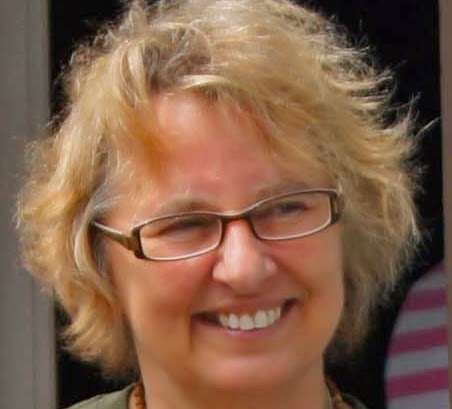 Nina Munteanu is a Canadian ecologist and internationally published novelist of science fiction and fantasy. In addition to eight published novels, Nina has written award-nominated short stories, articles and non-fiction books, which have been translated into several languages throughout the world. She currently teaches writing at The University of Toronto and George Brown College.
Nina Munteanu is a Canadian ecologist and internationally published novelist of science fiction and fantasy. In addition to eight published novels, Nina has written award-nominated short stories, articles and non-fiction books, which have been translated into several languages throughout the world. She currently teaches writing at The University of Toronto and George Brown College.
Published on July 03, 2014 15:27
June 27, 2014
Surfing the Hybrid Wave of Publishing
 photo by Clark LittleBestsellers have been migrating online since Amazon.com opened its virtual doors in 1995. Now ¾ of them are online, e-books and print combined. Two years ago Borders shut its doors. Mike Shatzkin of the Shatzkin Files tells me that Barnes & Noble continues to close stores as leases expire.
photo by Clark LittleBestsellers have been migrating online since Amazon.com opened its virtual doors in 1995. Now ¾ of them are online, e-books and print combined. Two years ago Borders shut its doors. Mike Shatzkin of the Shatzkin Files tells me that Barnes & Noble continues to close stores as leases expire.Our very own Chapters/Indigo in Canada is rapidly turning into a gift store. Mid-listed and lower listed authors are finding their print books returned to them (I know; I’m one of them). Further to that, I can also state that the digital version of my books—available in multi-formats including print, audio, e-book, and graphic novel—is selling at a ratio of at least 5 to 1 over any other format sold. Amazon recently revealed that Indie and small-press books account for half of the e-book sales in its most popular and bestselling genres. In a startling and controversial statistical report, Writer Hugh Howey determined that 92% of the top-100 best-selling books in the top-selling genres (based on Amazon sales) are e-books.
Despite the challenge on the use of statistics and data reporting in the Howey study, some of the overall trends he discussed (though the study may not have proven) are becoming obvious.
Over the past six years a mass migration into e-books has occurred—thanks to Kindle. We’ve had three years of great “hand-held delivery” of graphics—thanks to the iPad. Novels and non-fiction have blossomed over the Internet and into our cherished smart phones and other portable devices. It’s only time before consumers of illustrated books and children’s books embrace this market. One of my colleagues is counting on it. She has just completed an annotated version of an Edwardian illustrated guide to pets that is splendid with old plates and wonderful anecdotes. And it will be sold only as an e-book.
 photo by Clark Little
photo by Clark LittleA bazillion ebook retailing models are sprouting to embrace the flourishing of individual expression and readers who use Kindle, Kobo, and other portable reading devices. For instance there’s Safari, 24symbols, Oyster, Scribd, Entitle, and Librify. Then there’s Amazon’s PRIME, a kind of “library” lending service for its subscribers. They also have Kindle Fire for kids.
The big publishers have shifted majorly to ebooks to improve their margins and profitability. Even literary agents are dabbling in the publishing business now (e.g., E-Reads, Diversion, Rosetta, Curtis Brown, Writer’s House).
This is all great news for the self-published author, who is increasingly relying on the ebook format and Internet distribution platform of social media to earn a living as a writer.
 photo by Clark LittleOf a surety, the number of self-published books that succeed is still a tiny fraction of the number of books published overall. However, this needs to be seen in the greater context: the number of successful books (as gauged by various measures of “bestselling-status”), no matter how published, has always been a crap shoot, with many books not enjoying the kind of success their authors would wish—or deserve. The number of books mid-listed and below has always been a very high percentage of the totality. As with most niche markets, publishing success and sales has followed and continues to follow a long tail, with the few earning a lot stretching its long tail to the many earning a little. “The number of people reading wasn’t enough to support the number of authors publishing traditionally,” author Hugh Howey points out in an article called “I See it Half-Full”. This, no matter how a book is published or by whom.
photo by Clark LittleOf a surety, the number of self-published books that succeed is still a tiny fraction of the number of books published overall. However, this needs to be seen in the greater context: the number of successful books (as gauged by various measures of “bestselling-status”), no matter how published, has always been a crap shoot, with many books not enjoying the kind of success their authors would wish—or deserve. The number of books mid-listed and below has always been a very high percentage of the totality. As with most niche markets, publishing success and sales has followed and continues to follow a long tail, with the few earning a lot stretching its long tail to the many earning a little. “The number of people reading wasn’t enough to support the number of authors publishing traditionally,” author Hugh Howey points out in an article called “I See it Half-Full”. This, no matter how a book is published or by whom.What does this mean to those of you just getting started and still choosing which route to follow?
Those of us in the industry have been hearing some interesting back and forths spanning from writers like John Green who passionately maintains that he would “never self-publish” and that there is an advantage to publishing the traditional route to others like Brenna Aubrey who turned down an auctioned offer from a Big Five publisher to self-publish with no regrets and to great success.
 photo by Clark Little
photo by Clark LittleIn an article entitled “the Third Way of Book Publishing”, successful self-published author Mathew Mather argues for a hybrid approach. In the article, he shares how he became a successfully published author without the help of any of the Big Five publishers and the results were incredible :
“By self-publishing and without any help from the Big Five, I’ve gathered nearly 200,000 readers in under two years. This was only possible because of the new platforms and outlets that became available to authors in the past few years. Without them, I wouldn’t be an author, or at least, not a ‘published author’. And, because of my self-publishing success, 20th Century Fox purchased the film rights to my second novel, CyberStorm.”
Mather suggests an alternative paradigm that mixes self-publishing with traditional publishing and involves the author’s rights. Mather says that “If a writer manages to get out a self-published book that is successful, they can separate out rights for: domestic US, Canada, UK, rest of world country by country, audio rights, film and TV rights and so on.” Mather himself kept self-publishing in the US domestic market (both print and electronic) and sold off rights for foreign markets through an agent or through larger traditional publishers.
 photo by Clark LittleMather provides the example of Hugh Howey, who kept his electronic publishing rights while doing print deals with other publishers. I’ve done the same for several of my books. While I collect small royalties (12%) from my American Indie publishing house who has bought the rights to the print version of The Splintered Universe, I kept the rights to the e-book version, which I sell on Amazon KDP for a much higher royalty (70%). I make more per e-book despite its reduced retail price; and, as I mentioned above, I sell more e-books than print books, by about 5:1. Howey provides more interesting statistics for writers to consider.
photo by Clark LittleMather provides the example of Hugh Howey, who kept his electronic publishing rights while doing print deals with other publishers. I’ve done the same for several of my books. While I collect small royalties (12%) from my American Indie publishing house who has bought the rights to the print version of The Splintered Universe, I kept the rights to the e-book version, which I sell on Amazon KDP for a much higher royalty (70%). I make more per e-book despite its reduced retail price; and, as I mentioned above, I sell more e-books than print books, by about 5:1. Howey provides more interesting statistics for writers to consider.This is an exciting time. The writing and publishing industry is experiencing a tidal wave of change. If you like waves and don’t mind getting a little wet, chances are you’ll enjoy an awesome ride. Publishing success now and in the future will not rely on any single model. It doesn’t matter if you use a longboard, gun, fish or bonzer. Just get up and surf the wave.
As with other facets of business and art that have been touched by the Internet, storytelling is currently experiencing a renaissance of individual expression that will involve many different ways to express, communicate and distribute “story”—some yet to be imagined.
Interesting Links:
Nina's Future How We Will Tell Stories in the Future The Future of Books Nina on Amazing StoriesBeating Today's S-Curve The Indie Book Tidal Wave Nina's Interview on EAC's Boldface
Published on June 27, 2014 09:38
June 26, 2014
Orphan Black Clone Dance: Love the Water...
 This wonderfully choreographed scene from the Season 2 finale of Orphan Black, demonstrates some of what is the very best in this scintillating and compelling Canadian science fiction thriller: character.
This wonderfully choreographed scene from the Season 2 finale of Orphan Black, demonstrates some of what is the very best in this scintillating and compelling Canadian science fiction thriller: character.Tatiana Maslany is one person but when you see each of those women interacting--with each other and with Felix--you never for once think of them as the same person. Each "clone" is an obvious individual, in her nuances, facial expressions, speech and--yes--in her movements, which include how she dances.

From the fluid "water" moves of Cosima to Sarah's lithe animal power to Alison's uptight staccato steps and finally to Helena's unbridled abandon...
Kudos to Tatiana Maslany. She is a very accomplished actor. And so fun to watch!
Google "Orphan Black Clone Dance" and enjoy the dance!
Great music by Adham Shaikh, Juno and Emmy Award-nominated musician from Nelson, British Columia.
 Adham ShaikhCalled "Water Prayer" this dub hip hop tune is an inspired prayer to celebrate water. Released from Universal Frequencies in June 14, 2010, it was featured at the Water woman festival in Vilcabamba, Equador in 2012.
Adham ShaikhCalled "Water Prayer" this dub hip hop tune is an inspired prayer to celebrate water. Released from Universal Frequencies in June 14, 2010, it was featured at the Water woman festival in Vilcabamba, Equador in 2012.An admitted interstellar traveller, specializing in global sounds of bass, fusing dance culture with ancestors vibrations, Adham's music transcends time and place. A mix of styles and forms from ambient to progressive, glitch hop to trip hop, klezmer to raga's, a bit of dub n breaks to blend it all together with tribal beats to get the feet moving. And, yes, those feet wanna move--even Cosima's!
Published on June 26, 2014 19:30
November 21, 2013
The Writer's Toolkit Workshop with Nina Munteanu
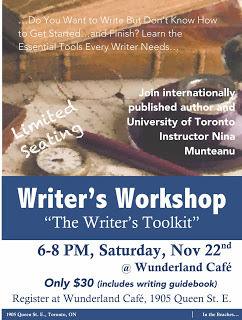 I'm giving the first of a series of writing workshops this coming Saturday, November 23rd 2013 from 6 pm to 8 pm at Wunderland Cafe in The Beaches, Toronto.
I'm giving the first of a series of writing workshops this coming Saturday, November 23rd 2013 from 6 pm to 8 pm at Wunderland Cafe in The Beaches, Toronto.The Writer's Toolkit Workshop:
Every writer requires some necessary items in his/her toolkit to get published. This workshop introduces and discusses the most common challenges faced by writers serious about getting published. Areas covered include:
getting starteddealing with time management & writer’s blockgetting those ideas down and making a story out of themfocusing and maintaining the staying power to finishincorporating all the elements of good storytelling like plot, character, theme and setting into a seamless storymaking your writing compelling, clear and excitingdoing research and editingmarketing, synopses & outlines, query lettersovercoming fear (of failure, of success, of everything)
Cost is $30 and includes one of my writing guidebooks (valued at $27.95). Seating is limited so either register in advance or come early, buy one of Wunderland's excellent European-style coffees and grab a seat in the cafe.
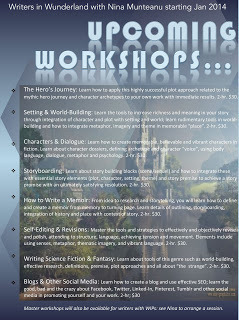 The Writer's Toolkit is the first of a series of monthly writing workshops I will be giving starting January 2014. You can register for any of them in advance once the schedule is finalized in early January.
The Writer's Toolkit is the first of a series of monthly writing workshops I will be giving starting January 2014. You can register for any of them in advance once the schedule is finalized in early January.Venue: Wunderland Gallery and Espresso Bar, 1905 Queen St. East, Toronto (The Beaches).
Published on November 21, 2013 07:06
November 4, 2013
Hero Against the Bully: Rachel Parent and GMO Labeling
 When she was twelve years old, Rachel Parent did a school project on genetically modified foods. It changed her life.
When she was twelve years old, Rachel Parent did a school project on genetically modified foods. It changed her life.That was two years ago. Today, Parent is the founder of Kids Right to Know, an organization that promotes labeling food to reflect its content, and she speaks at events like the recent global “March on Monsanto” in Toronto, ON. She scored several goals in a face off with Kevin O’Leary on CBC’s TheLang and O’Leary Exchange.
In that short time since her school project, this young teenager has informed herself extremely well and can eloquently explain her position on the right to know labeling campaign, what risks GMO products pose to the environment and ourselves, and the insidious nature of how multinational GMO-producing corporations like Monsanto are contributing to this potential negative impact.
Her main issue is also mine: the purposeful deception by corporations (and governments) for self-serving reasons. Being a bully. Not playing nice.
The Right To Know
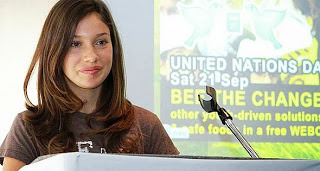 Rachel ParentNo matter what people might believe about GMO and its effects on ecosystem function, biological integrity and human health, enough concern has been raised to warrant clarity in product description. This is a democratic right.
Rachel ParentNo matter what people might believe about GMO and its effects on ecosystem function, biological integrity and human health, enough concern has been raised to warrant clarity in product description. This is a democratic right.Our democratic free world is predicated on transparency and freedom of choice. Citizens of the world have demonstrated the need to know and choose according to their beliefs. In order to make informed choices, we must have enough information—in this case the presence, or not, of GM foods in consumables. Mandatory labeling of consumables made from GMO products currently exists throughout the world—with the exception of most of the United States (some states like Connecticut have instituted their own laws) and Canada. “Canada,” Parent tells us, “is one of only two industrialized nations in the world that don’t have mandatory GMO labeling. The other country is the United States.”
“The truth is,” says Parent, “it’s no coincidence that since GMOs have been introduced into our food system, we’ve started seeing more cases of irritable bowel syndrome, leaky gut syndrome, acid reflux, infertility, cancer, autism, Parkinson’s and many other diseases. Unfortunately, it seems like we’re all a big part of a science experiment.” She adds, “All of this could lead up to be the most devastating, destructive, unspoken environmental catastrophe of all time. “Unfortunately, the media is not talking about it because most of their advertisers are brands that use GM ingredients. In fact, over 90% of the advertised packaged goods that are advertised on TV contain GMOs, such as corn, canola, soy, vegetable oils and high fructose corn syrup.”
 Parent’s goal is “to make sure that food is clearly and accurately labeled [for all Canadians] and then people can choose for themselves.” Parent has certainly made up her mind and chosen for herself. But, having made that choice, she admits to the challenge of living by it, based on the lack of sufficient labeling. So, Parent makes a best guess, based on what she knows. She avoids corn, canola, soy, and vegetable oil “because,” says Parent, “if you’re eating food that contains these ingredients, there’s about a 90% chance that they contain GMOs.” The evidence, in fact, is clear regarding the risk to both human health andnatural ecosystems that GMO pose. For instance, the American Academy of Environmental Medicine (AAEM) reported that “several animal studies indicate serious health risks associated with GM food.” Studies identified infertility, immune problems, accelerated aging, faulty insulin regulation, and changes to major organs and the gastrointestinal system as impacts created by GM foods.
Parent’s goal is “to make sure that food is clearly and accurately labeled [for all Canadians] and then people can choose for themselves.” Parent has certainly made up her mind and chosen for herself. But, having made that choice, she admits to the challenge of living by it, based on the lack of sufficient labeling. So, Parent makes a best guess, based on what she knows. She avoids corn, canola, soy, and vegetable oil “because,” says Parent, “if you’re eating food that contains these ingredients, there’s about a 90% chance that they contain GMOs.” The evidence, in fact, is clear regarding the risk to both human health andnatural ecosystems that GMO pose. For instance, the American Academy of Environmental Medicine (AAEM) reported that “several animal studies indicate serious health risks associated with GM food.” Studies identified infertility, immune problems, accelerated aging, faulty insulin regulation, and changes to major organs and the gastrointestinal system as impacts created by GM foods. The AAEM asked physicians to advise patients to avoid GMfoods. The only human feeding experiment revealed that the genetic material inserted into GM soy transfers into bacteria living inside out intestines and continues to function—long after we stop eating GM foods. While no study has been done to date about gene transfer, if the antibiotic gene inserted into most GM crops were to transfer, it could create super diseases, resistant to antibiotics. If the gene that creates Bt-toxin in GM corn were to transfer, it might turn our intestinal bacteria into living pesticide factories.
In a recent interview with Courtney Shea of Toronto’s The Grid, Parent explained that Health Canada’s official position of genetically modified food being as healthy as other food is based on dangerously limited and potentially biased scientific evidence: “Health Canada relies on tests that are conducted by the [very] companies [who produce the product] … and who stand to profit from GMOs. The companies doing the testing are only testing for [periods of] 90 days. How does 90 days determine how these things might affect us in the long term?”
This is the $$$$$ question.
What Is Really Being Tested?
 The acute 90-day test used by Monsanto and other GMO researchers, is just one of many types of toxicity tests conducted by toxicologists in risk assessment studies of varying exposure.
The acute 90-day test used by Monsanto and other GMO researchers, is just one of many types of toxicity tests conducted by toxicologists in risk assessment studies of varying exposure.One can generally characterize toxicity tests as:
1) Acute Tests, which test the immediate, worse-case effects of a compound, usually measured through the concentration that kills fifty percent of the organisms tested: LC50); and
2) Chronic Toxicity Tests, which assess a quantitative biological function, usually growth or reproductive success (not death), usually measured through the NOEC [no observed effect concentration]).
Both kinds of tests should be run to provide a realistic and robust measure of effect (e.g., both intense short term and chronic long term). The latter is more often what occurs in the real world because of its insidious nature. Low dose chronic exposure is therefore a critical measure for the following reasons: 1) this dose is less likely to be noticed and may add to critical accumulative effects; 2) because of this, chronic doses may exist for prolonged periods with greater hidden adverse effects; 3) this dose may affect different receptors than higher doses with great hidden costs; 4) this dose, though not lethal, is less likely to be regulated and therefore more likely to contribute to aggressive negative synergy; 5) this dose is more likely to be encountered and persist in the environment for all the reasons given above.
In 2012, French and Italian scientists headed by Gilles-Eric Seralini (see the entire Séralini et al. paper here), published the results of a two-year long term sub-chronic toxicity study of a Roundup herbicide and a Roundup-tolerant genetically modified maize in Food and Chemical Toxicity—the first of its kind. Authors concluded in their paper that: "The results of the study...clearly demonstrate that lower levels of complete agricultural guy-phosphate herbicide formulations, at concentrations well below officially set safety limits, induce severe hormone-dependent mammary,hepatic and kidney disturbances."
Despite the barrage of bad press and efforts to discredit the two-year study on rats (it has since been validated by the European Food and Safety Authority), the paper’s results cannot be refuted entirely or ignored (if only from the basis of scientific inquiry and professional due diligence to do with Type II Error). The Truth and OtherLies
 In November 2012, California’s Proposition 37, the bill to enforce the labeling of GMO products, was defeated. In an article entitled, “Writing About Truth…and Other Lies” I explored why. Over $47 million dollars were spent to fight the California ballot for the right to know. That campaign ultimately revealed a surprising “who’s who” in the GMO controversy. When some of the largest “organic” brands like Kashi, Cascadian Farm, and Horizon Organic joined the anti-labeling effort, it was no surprise that these “organic” brands are owned by larger conglomerates like Kellogg, General Mills, Dean Foods, Smucker’s and Coca-Cola—all companies, along with Monsanto, PepsiCo., Nesléand ConAgra Foods, that use GMO materials in their products. Companies who supported the bill to label GMO products included Whole Foods, Nature’s Path (a Canadian company) Organic Valley, Cliff Bar and Amy’s Kitchen—brands that do not use GMO.
In November 2012, California’s Proposition 37, the bill to enforce the labeling of GMO products, was defeated. In an article entitled, “Writing About Truth…and Other Lies” I explored why. Over $47 million dollars were spent to fight the California ballot for the right to know. That campaign ultimately revealed a surprising “who’s who” in the GMO controversy. When some of the largest “organic” brands like Kashi, Cascadian Farm, and Horizon Organic joined the anti-labeling effort, it was no surprise that these “organic” brands are owned by larger conglomerates like Kellogg, General Mills, Dean Foods, Smucker’s and Coca-Cola—all companies, along with Monsanto, PepsiCo., Nesléand ConAgra Foods, that use GMO materials in their products. Companies who supported the bill to label GMO products included Whole Foods, Nature’s Path (a Canadian company) Organic Valley, Cliff Bar and Amy’s Kitchen—brands that do not use GMO. Whenever an issue of importance arises, the truth reveals itself. When someone fights against transparency, condones secrecy, and ultimately promotes deception alarm bells should go off.
The controversy over the benefits and risks of GMO products continually rages today, despite sound research findings from years of experimentation that provide alarming evidence on the risks of GMO practice, both to the Earth’s ecosystems and human health directly. I’m sad to say that much of the controversy is due to huge propaganda efforts by multi-nationals (and governments) who have created an Orwellian reality that has made a lie “a truth”. It is interesting to note here that when someone like Rachel Parent, does her homework and speaks out, she is challenged and berated by media buffoons.
In her article The Seeds of Suicide: How Monsanto Destroys Farming in Global Research, Dr. Vandana Shiva tells us that, “Control over seed is the first link in the food chain because seed is the source of life. When a corporation controls seed, it controls life, especially the life of farmers.”
Dr. Shiva adds, “Patents on seed are illegitimate because putting a toxic gene into a plant cell is not “creating” or “inventing” a plant. These are seeds of deception — the deception that Monsanto is the creator of seeds and life; the deception that while Monsanto sues farmers and traps them in debt, it pretends to be working for farmers’ welfare, and the deception that GMOs feed the world. GMOs are failing to control pests and weeds, and have instead led to the emergence of superpests and superweeds… A renewable resource became a non-renewable, patented commodity.”
Ecosystem Risks and Dangers of GMO
 In 2007 I published an article here entitled “Biomimicry,Nature’s Alternative to Genetically Engineered Foods”, I explored the risks to ecosystem balance posed by genetically engineered crops. In the article I reiterated ecologists’ fear—based on years of research—of potential devastation from genetically modified crops released in the natural ecosystem. Jane Rissler of the Union of Concerned Scientists of America suggested that transgenic science practices may release a seemingly harmless gene into our food supply with life-threatening consequences.
In 2007 I published an article here entitled “Biomimicry,Nature’s Alternative to Genetically Engineered Foods”, I explored the risks to ecosystem balance posed by genetically engineered crops. In the article I reiterated ecologists’ fear—based on years of research—of potential devastation from genetically modified crops released in the natural ecosystem. Jane Rissler of the Union of Concerned Scientists of America suggested that transgenic science practices may release a seemingly harmless gene into our food supply with life-threatening consequences. “The genome is a miniature ecosystem,” said Dr. Wes Jackson, director of the Land Institute in Kansas, a non-profit research facility devoted to alternative agricultural practices. He warns that, if misused, biotechnology may lead to the human-induced degradation of the genomes of plant species. “What is being more or less ignored” in the rush to biotechnology, he said in an interview with the Chronicle of Higher Education, “is that some of the same principles and processes that govern an ecosystem, like a forest or a prairie, also operate with genomes.”
Jackson and The Land Institute promotes “natural systems agriculture”, a polyculture of herbaceous perennials, that provide a natural alternative to genetically engineered crops.
Seralini Reference and Links to Other Studies:
Seralini, G.-E.,et al. Long term toxicity of a Roundup herbicide and a Roundup-tolerant genetically modified maize. Food Chem. Toxicol. (2012).
GM Corn Damages Liver and Kidneys Meat Raised on GM Feed is Different Roundup Could Cause Birth Defects Genetically Modified Soy Linked to Sterility Damaging Effects of Roundup GM Crops Do Not Increase Yields
GMOs Inevitably Contaminate and Persist
Published on November 04, 2013 12:26
October 29, 2013
The Island, movie review
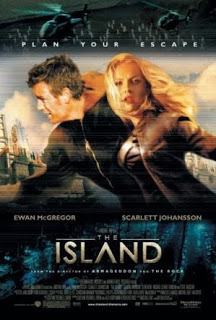 From its metaphoric title to its powerful end, Director Michael Bay’s The Island had me fully engaged. Told in the genuine style of great science fiction commentary by screenwriters Caspian Tredwell-Owen, Alex Kurtzman and Roberto Orci (in 2005), The Island reflects the escape-from dystopia films of the 1960s and 70s such as Fahrenheit 451, THX 1138, and Logan’s Run. This elegant story examines a full range of human foibles—consumerist greed, racism, fascism and isolationism—through a premise that is as frightening as it is possible.
From its metaphoric title to its powerful end, Director Michael Bay’s The Island had me fully engaged. Told in the genuine style of great science fiction commentary by screenwriters Caspian Tredwell-Owen, Alex Kurtzman and Roberto Orci (in 2005), The Island reflects the escape-from dystopia films of the 1960s and 70s such as Fahrenheit 451, THX 1138, and Logan’s Run. This elegant story examines a full range of human foibles—consumerist greed, racism, fascism and isolationism—through a premise that is as frightening as it is possible.In the year 2019, Lincoln Six Echo (Ewan McGregor) and Jordan Two Delta (Scarlett Johansson) live in an isolated community where behavior is governed by a set of strict rules. This includes the avoidance of too close contact. Everything is the same; residents all wear the same white uniform and carry out simple duties. They’ve been told that the outside world is too contaminated for human life with the exception of one island. Everyone lives for the weekly lottery, where the winner gets to leave the compound to live on the island.
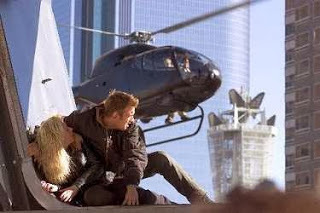
It’s a simple and banal existence. We glimpse a scene of adults reading Dick and Jane out loud. When in the opening scene Lincoln Six Echo finds a shoe missing in his provided wardrobe, this becomes a major focus of his day (when greeted by a colleague with, “How are you doing?” he responds with, “I’m missing a shoe.”)Lincoln can’t accept this mundane existence. In an interview with Dr. Merrick (Sean Bean), the scientist who runs the compound, Lincoln naively unleashes a tirade of items that frustrate him, like why everyone wears white, who determined tofu Tuesday, and then ends with: “I want to know answers and I wish there was more than just waiting to go to the island.” He also suffers from dreams about a life he doesn’t understand—they are, in fact, memories of his ‘sponsor’, the original man (Tom Lincoln) that he is a copy of. When he discovers a moth and follows it, he stumbles into the hidden part of the compound. There he witnesses what really happens to “lottery winners”: they are killed and used for organ harvesting, surrogate motherhood, etc. for each one’s sponsor.
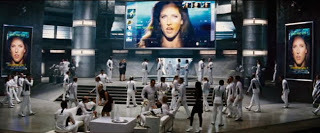 Lincoln is just an insurance policy. An ‘agnate’ according to Dr. Merrick, who describes them as in a “persistent vegetative state that never achieves consciousness” to clients, willing to pay millions of dollars for a second chance at life—and blithely unaware that ‘agnates’ are alive and fully formed with thoughts and feelings like them. When Lincoln learns the truth, and knowing that Jordan just “won” the lottery, he convinces her to escape with him. Merrick hires Albert Laurent (Djimon Hounsou), a mercenary and former GIGN veteran, to find and dispatch them.
Lincoln is just an insurance policy. An ‘agnate’ according to Dr. Merrick, who describes them as in a “persistent vegetative state that never achieves consciousness” to clients, willing to pay millions of dollars for a second chance at life—and blithely unaware that ‘agnates’ are alive and fully formed with thoughts and feelings like them. When Lincoln learns the truth, and knowing that Jordan just “won” the lottery, he convinces her to escape with him. Merrick hires Albert Laurent (Djimon Hounsou), a mercenary and former GIGN veteran, to find and dispatch them.
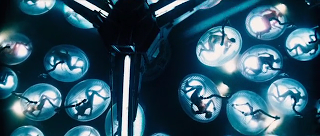
The Island received mixed reviews from critics, with a 40% “Rotten” rating, based on 185 reviews. Variety’sJustin Chang called the film an “exercise in sensory overkill.” Salon’s Stephanie Zacharek lamented that when the film got really interesting, Bay seemed to think he needed “to throw in a car crash or round of gunfire to keep our attention.” If these critics found fault with this elegant action-thriller, I hate to see what they make of 90% of the so-called SF movies out there today. Unlike them, The Island provides a refreshing meaningful face to action-adventure.
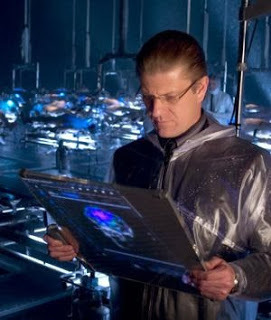 Sean Bean as Dr. MerrickRoger Ebert suggested that The Island missed the opportunity “to do what the best science fiction does, and use the future as a way to critique the present.” Again, I disagree. The Island does what the best science fiction does well: it examines the nature of our humanity through the choices we make in adversity within a future world and premise that provides great opportunity for abuse.
Sean Bean as Dr. MerrickRoger Ebert suggested that The Island missed the opportunity “to do what the best science fiction does, and use the future as a way to critique the present.” Again, I disagree. The Island does what the best science fiction does well: it examines the nature of our humanity through the choices we make in adversity within a future world and premise that provides great opportunity for abuse. The theme of this parable is carried evocatively by Steve Jablonsky’s score. Like a swelling tide it sweeps us on a journey to some distant shore. From the melodic strings and yearning chorus, the music builds to a powerful conclusion at the film’s end, when it lifts us to victory, resonating with our divine evolution. I was particularly struck by the timing of the strings and chorus with the appearance of Albert Laurent, walking among those he had just liberated. It is a pivotal and powerful moment that escalates into a resonating vibration of liberty and victory as his eyes meet briefly with Lincoln and Jordan, reunited, and he smiles—for the first time. A beautiful smile of inner joy. It is the smile of a man who has “come home” and is finally free.
Laurent’s subplot is particularly compelling and carries one of the principle elements of the film. In
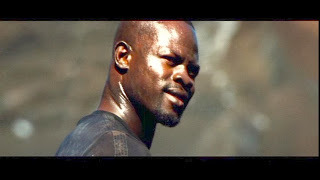 Djimon Housou as Albert Laurentsome ways, Laurent represents you and me, caught up in our societal ‘duties’, seduced by self-serving entrapments only to awaken to a path of courageous compassion for all of humanity. Laurent’s journey from jaded mercenary to liberating hero begins when he notices Jordan’s skin branding and, recognizing a connection with her plight, helps her free the mass of ‘defective’ lottery winners about to be incinerated. We learn that his father had been killed as a rebel and Laurent was ‘branded’ as less than human. So, there he walks, brilliantly black among the white-clad ‘agnates’ who slide down the hill after emerging from the underground bunker in which they were incarcerated.
Djimon Housou as Albert Laurentsome ways, Laurent represents you and me, caught up in our societal ‘duties’, seduced by self-serving entrapments only to awaken to a path of courageous compassion for all of humanity. Laurent’s journey from jaded mercenary to liberating hero begins when he notices Jordan’s skin branding and, recognizing a connection with her plight, helps her free the mass of ‘defective’ lottery winners about to be incinerated. We learn that his father had been killed as a rebel and Laurent was ‘branded’ as less than human. So, there he walks, brilliantly black among the white-clad ‘agnates’ who slide down the hill after emerging from the underground bunker in which they were incarcerated. 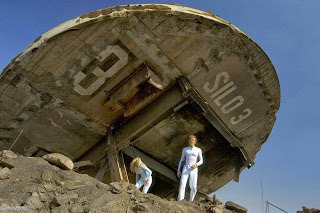 This motion picture is ultimately about finding dignity in the face of adversity and ridicule. It is about confronting the bully and gaining victory over one’s own barriers of fear and doubt toward compassion. It is about the power of love and connection with humanity. It is about retribution and finding one’s true path through the knowledge that we are all one.
This motion picture is ultimately about finding dignity in the face of adversity and ridicule. It is about confronting the bully and gaining victory over one’s own barriers of fear and doubt toward compassion. It is about the power of love and connection with humanity. It is about retribution and finding one’s true path through the knowledge that we are all one. “I am you; you are me. You are the waves; I am the ocean. Know this and be free, be divine.” Sri Sathya Sai Baba
Published on October 29, 2013 13:04



